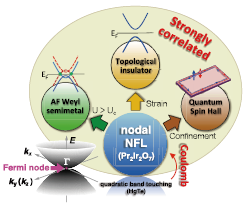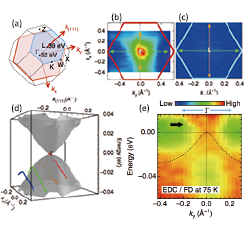Quadratic Fermi Node in a 3D Strongly Correlated Semimetal
Kondo, Nakatsuji, and Shin Groups
Strong spin–orbit coupling fosters exotic electronic states such as topological insulators and superconductors, but the combination of strong spin–orbit and strong electron–electron interactions is just beginning to be understood. Central to this emerging area are the 5d transition metal iridium oxides [1-4]. Here, in the pyrochlore iridate Pr2Ir2O7, we identify a non-trivial state with a single-point Fermi node protected by cubic and time-reversal symmetries, using a combination of angle-resolved photoemission spectroscopy and first-principles calculations. Owing to its quadratic dispersion, the unique coincidence of four degenerate states at the Fermi energy, and strong Coulomb interactions, non-Fermi liquid behavior is predicted, for which we observe some evidence. Our discovery implies that Pr2Ir2O7 is a parent state that can be manipulated to produce other strongly correlated topological phases, such as topological Mott insulator, Weyl semimetal, and quantum spin and anomalous Hall states.

Fig. 1. Quadratic Fermi node state of Pr2Ir2O7 tunable into interacting topological phases. In the lower part of the diagram, the bottom half of the blue circle and its reflection form a caricature of the quadratically dispersion conduction and valence bands touching at the zone centre, while at the same time the darker-blue upper circle suggests how Pr2Ir2O7, with non-negligible Coulomb interactions, is a strongly correlated non-Fermi liquid analogue of HgTe, shown as a pale-blue reflection. Arrows indicate the perturbations that convert the nodal non-Fermi liquid state to diverse topological phases.

Fig. 2. Fermi node state of Pr2Ir2O7 revealed by ARPES with synchrotron radiation source. (a) Brillouin zone, showing measured momentum sheets. (b,c) ARPES intensities at EF in the kx-ky sheet crossing Γ and L measured at hv=52eV and 39eV, respectively. The calculated band dispersion in the kx-k(111) sheet. Energy dispersions determined by ARPES are plotted on it. (e) ARPES dispersion map crossing Γ, measured at an elevated temperature (T=75K).
The experimental evidence for a quadratic Fermi node state in Pr2Ir2O7 is demonstrated in Fig. 2. In the panel (d), we observe that a parabolic energy-dispersion approaches EF with increasing photon energies (or kz values), and finally touches it at the Γ point (a red curve). We have confirmed that, with further increase of kz, the dispersion gets away from EF again, which signifies that the 3D band structure of Pr2Ir2O7 has a single Fermi point (Fig. 2(b)). Other scans of different kz values up to the L point (Fig.(c)) revealed no other states touching or crossing EF. This circumstance satisfies the charge neutrality, and it could be a further evidence for the realization of nodal state. We also find that the broad spectral weight emerges beyond EF as seen in the Fermi-function-divided image for the 75K data (arrow in Fig. 2(e)). This observation is compatible with the predicted existence of a quadratic band touching on the unoccupied side.
References
- [1] B. J. Kim et al., Science 323, 1329 (2009).
- [2] Y. Machida et al., Nature 463, 210 (2009).
- [3] D. Pesin et al., Nature Physics 6, 376 (2010).
- [4] X. Wan et al., Phys. Rev. B 83, 205101 (2011).
- [5] T. Kondo et al., Nature communications 6, 10042 (2015).
